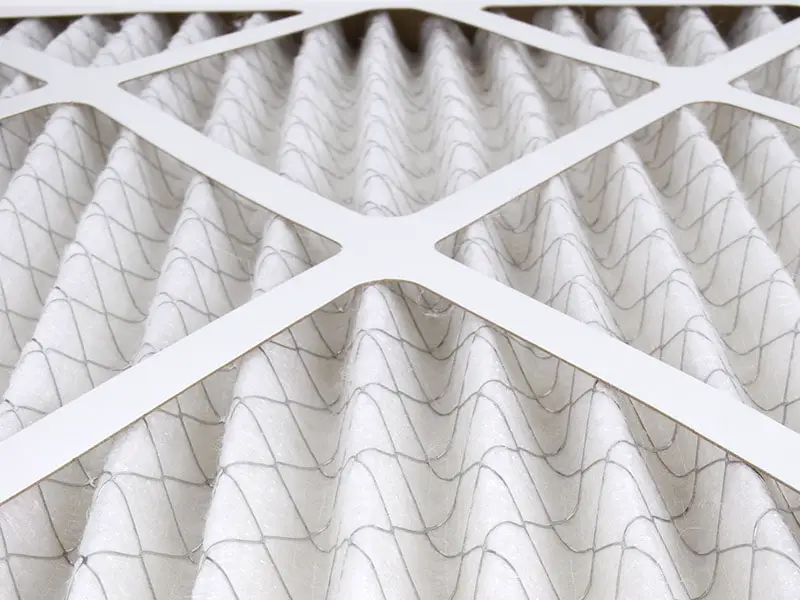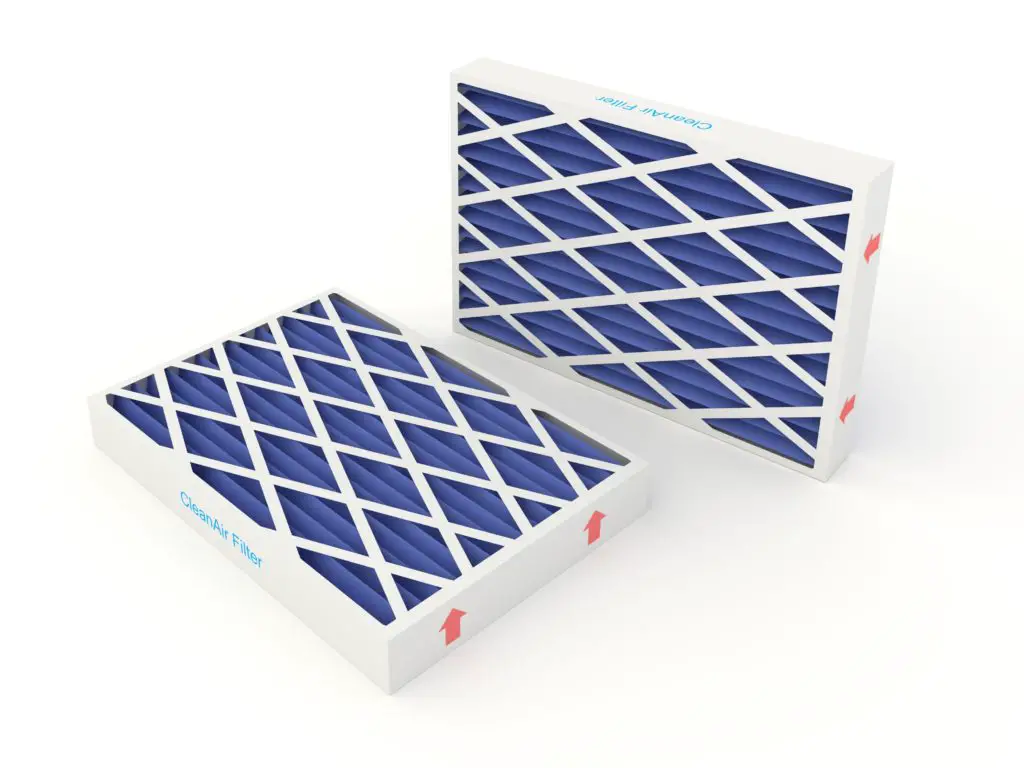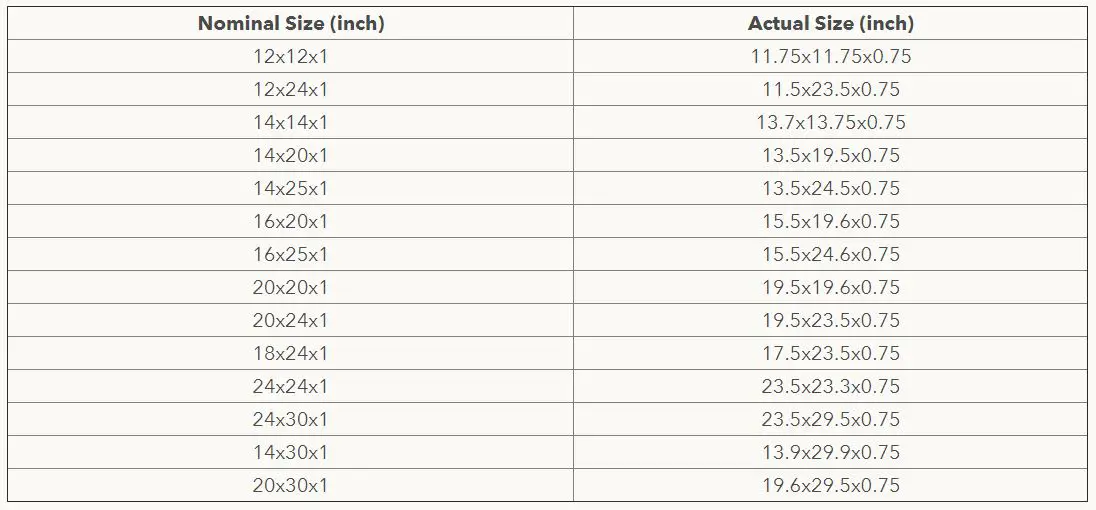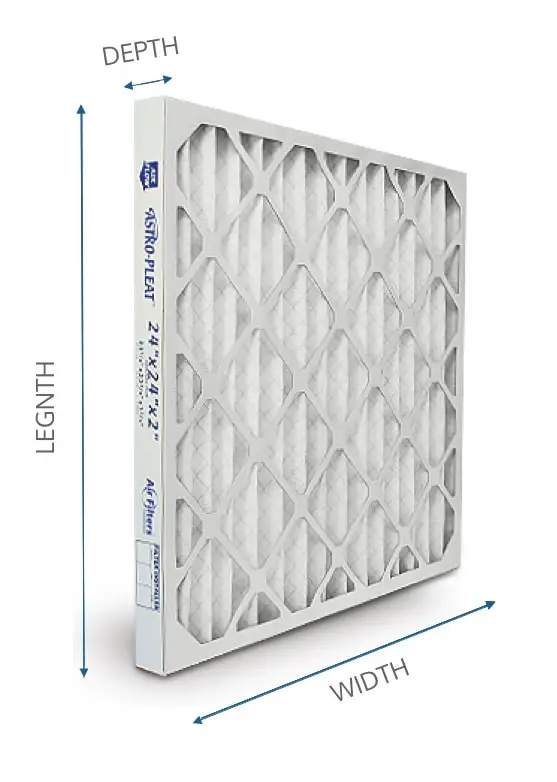Using the correct air filter size for your air conditioner is essential to keep your system working efficiently.
If your filter doesn’t fit correctly, the air will take the path of least resistance and flow around the filter instead of through it.
This article will help you get the information you need to help you with your home’s air filtration system.

What Size Air Filter Do I Need for My Air Conditioner?
When purchasing an air filter, an important thing to remember is to round up to the nearest whole number. Rounding up is essential to allow enough space to install the filter without damage. This small size discrepancy isn’t an issue because the air being pushed and pulled creates a seal. Later in this article, we’ll teach you how to measure an air filter.
There are three ways to determine which size you need:
- Read the specifications or label
- Measure your current filter
- Measure the air intake
Importance of Knowing the Size of Your Air Conditioner Filter
It’s a lot easier to replace your air filters when you know the correct size to use. With the many different dimensions available, it can be easy to get overwhelmed when purchasing one. But, guessing the air filter size you need Isn’t a good idea.
Trying to use a filter that’s too large will cause it to break, and it won’t work correctly. With a filter that’s too small, there will be gaps and contaminants will go around the filter.

Standard AC Filter Sizes
The depth of the air filter determines indoor air quality; residential filters can range from one to five inches. Air filters that have a greater thickness don’t need to be replaced as often. Filters with a depth of one inch should be replaced after one to three months, while those that are four inches can stay in for a year.
As the number of layers and the surface area gets bigger, more nets and layers catch more airborne particulates. Capturing more dust causes thicker filters to last longer and catch more dust and dirt without restricting airflow.
MERV Ratings
The dimensions of a filter are different from their minimum efficiency rating value (MERV) rating. This rating is based on the pore size of the materials in the filter. If a filter has a higher MERV rating, it has smaller pores and catches more particles.
All filter sizes come with a MERV rating. If that rating is between 1 and 4, it can catch particles like pollen, dust, textile fibers, spray paint, and sanding dust. A MERV rating between 5 and 8 can capture microbiological growths, hair and cleaning sprays, volatile organic compounds, and cement mixes. Filters with a MERV rating between 9 and 12 catch auto emissions and fumes, lead dust, milled flour, and humidifier dust.
Though it may seem that getting a filter with a higher MERV rating is the better choice, it may not be for you. With a higher rating, you’ll be paying more for the filter itself as well as the amount of energy being used. To cut down on unnecessary costs and energy spending, you should opt for a lower MERV rating based on your needs.

Energy Efficiency and Cost Savings
Having the correct air filter size is essential to keep your AC unit energy efficient. Installing the wrong air filter can cause many problems that’ll cost you a lot of time and money. Make sure you’re using the correct filter size and replacing it as needed. Having a clean air filter reduces your air conditioner’s energy spending significantly.
It may be tempting to change your air filters less often, but using dirty filters causes harm to the AC, costing more in the long run. Your utility bills increase, and you’ll eventually have to pay for repairs because of the damage caused by dirt build-up. With clean and well-fitting air filters, you’ll enjoy better air quality, more savings, and a healthy AC unit.
Air Conditioner Filter Size Chart
If you can’t easily install and remove an air filter, it’s not the correct size. This is why these filters are a little bit smaller than what’s printed on them.

Nominal vs Actual AC Filter Sizes – Comparison Overview
You might be wondering if there’s a significant difference between nominal and actual sizes. In this section, we’ll define the two so it’s easier to compare.
Nominal Size
The nominal size is what is written on the side of an air filter. You get this number by rounding the filter measurements up to the nearest whole number. With the hundreds of filter sizes, you can choose from the nominal size system, making sure you don’t have to get a custom air filter made when it’s time to change it out.
An easy way to understand this system better is to think of how different smartphones can use the same charger. Manufacturers use standardized cables, so all modern iPhones use the same chargers and most Androids use the same charger. Companies that make AC filters do the same thing to make it easier to find the correct air filter.

Actual Size
The actual size is just that; it’s the exact measurements of the filter. These numbers are accurate to an eighth of an inch. So if you were to get a standard filter with a nominal size of 20 x 20 x 1, the actual size could be 19¾ x 19¾ x ¾.
When looking for an air filter going by the nominal size is the easiest way to find what you’re looking for; the nominal size is printed on the filter’s side.

How to Measure Your AC Filter
Always turn your AC unit off before taking out your air filter. You’ll need a measuring tape to get the filter’s dimensions if they aren’t displayed on the side. There are three easy steps to follow to measure the filter:
- Measure the length, from top to bottom, then the width, from left to right (L x W). Unless you have a square filter, write the smaller measurement first.
- Measure the filter from front to back to get the depth.
- Combine the measurements in this format, L x W x D. It’s that easy. You can now be confident that you’re buying the right size filter for your AC.
Conclusion
Having an air filter that fits your AC unit is essential to good air quality in your home and preventing costly repairs in the future. If the dimensions of your current filter have rubbed off, you can measure it yourself easily. Remember that the measurements on the side of the filter are nominal sizes that have been rounded to the nearest whole inch.
People Also Ask
Hopefully, this article has helped you better understand air filter sizes and how important it is to get the right one. Here are a few common questions people ask when looking to replace their current filter.
The air filter you get shouldn’t have an airtight seal, but it should be easy to install and uninstall. It also shouldn’t be moving freely inside the AC unit. Going by the nominal size will make sure the filter will fit properly.
Using the wrong air filter won’t damage your AC unit right away. But, your unit won’t run as efficiently, which will raise your utility bills. The filter won’t be able to catch the dust before it starts building up in the unit, which will eventually damage the system.
The most common air filter sizes are 16x20x1, 16x25x1, 20x20x1, and 20x25x1. Each AC unit needs a specific size to run correctly and efficiently. Usually, these units use a standard-size filter, but sometimes a custom size is needed.
Running your AC without an air filter leaves the unit vulnerable to dirt and dust. This debris can cause damage to your HVAC system, and you’ll be paying a pretty penny in repairs. Air filters keep your HVAC system clean; the build-up of dirt causes air conditioners to break down.
Cutting an air filter makes it weaker and less efficient. This can cause the filter to collapse while installed. Dirt and debris will build up on the fan, slowing down airflow decreasing your air quality. It also creates a performance issue and costly repairs down the road.
